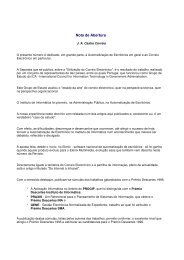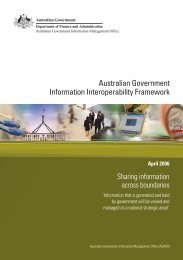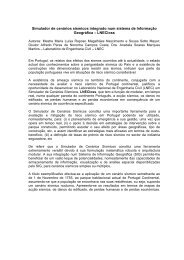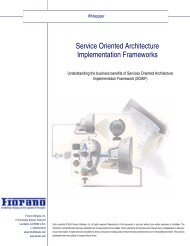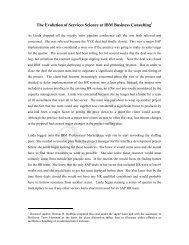OECD Peer Review of E-Government in Denmark - ePractice.eu
OECD Peer Review of E-Government in Denmark - ePractice.eu
OECD Peer Review of E-Government in Denmark - ePractice.eu
You also want an ePaper? Increase the reach of your titles
YUMPU automatically turns print PDFs into web optimized ePapers that Google loves.
services). Develop<strong>in</strong>g an all-<strong>of</strong>-government policy or strategy for both portals and Web sites, either as<br />
a stand-alone <strong>in</strong>itiative or as part <strong>of</strong> a wider multi-channel service delivery strategy, could provide a<br />
good vehicle to act on such recommendations, <strong>in</strong> pursuit <strong>of</strong> the efficient and effective development <strong>of</strong><br />
more user-focused e-government <strong>in</strong> the future.<br />
Key po<strong>in</strong>t 7.4<br />
The Danish public sector uses many Web sites and portals to deliver e-government, and <strong>in</strong>dications are that the<br />
number <strong>of</strong> Web sites and portals will cont<strong>in</strong>ue to grow. There is, however, no government-wide policy or strategy<br />
regard<strong>in</strong>g the design and development <strong>of</strong> Web sites and portals, either as a stand-alone <strong>in</strong>itiative or as part <strong>of</strong> a<br />
wider strategy on multi-channel service delivery.<br />
<strong>Denmark</strong> is already mak<strong>in</strong>g good progress <strong>in</strong> delivery <strong>of</strong> user-focused e-government. However, <strong>in</strong> the absence <strong>of</strong><br />
such overall guidance, there is potential for results to be sub-optimal <strong>in</strong> terms <strong>of</strong> both users’ e-government<br />
experiences, and the achievement <strong>of</strong> maximum efficiency and effectiveness <strong>in</strong> government use <strong>of</strong> the Internet as<br />
a delivery channel.<br />
E-government and <strong>of</strong>fl<strong>in</strong>e service delivery<br />
Given that the majority <strong>of</strong> government service delivery occurs at the local government level,<br />
perhaps the most significant user-focused step currently be<strong>in</strong>g taken is the proposed establishment, as<br />
part <strong>of</strong> implementation <strong>of</strong> the Structural Reform, <strong>of</strong> “Local Service Centres” under the authority <strong>of</strong><br />
each municipality. The logic is that the public sector should be as accessible as possible, and users <strong>of</strong><br />
government should be able to f<strong>in</strong>d services <strong>in</strong> one place, regardless <strong>of</strong> which public authority or<br />
adm<strong>in</strong>istration has f<strong>in</strong>al authority.<br />
Local Service Centres are <strong>in</strong>tended to <strong>in</strong>creas<strong>in</strong>gly become the physical front door to State,<br />
regional and municipal services – another reflection <strong>of</strong> the general Danish trend to make government<br />
closer to people and more user-focused. The function<strong>in</strong>g <strong>of</strong> the new Service Centres will be analogous<br />
to that <strong>of</strong> an Internet portal, and will depend on e-government for their implementation. The<br />
cross-organisation <strong>in</strong>formation management that will be required for their effective operation provides<br />
an excellent example <strong>of</strong> how e-government can expand beyond enabl<strong>in</strong>g onl<strong>in</strong>e delivery channels, and<br />
is <strong>in</strong>stead now becom<strong>in</strong>g <strong>in</strong>tegral to improv<strong>in</strong>g the performance <strong>of</strong> government when it is <strong>in</strong>volved <strong>in</strong><br />
face-to-face delivery <strong>of</strong> <strong>in</strong>formation and services.<br />
This relationship between e-government and <strong>of</strong>fl<strong>in</strong>e service delivery is highlighted <strong>in</strong> some <strong>of</strong><br />
the follow<strong>in</strong>g design pr<strong>in</strong>ciples, which will underp<strong>in</strong> implementation <strong>of</strong> the Service Centres:<br />
• Digital self-service solutions will be developed for all citizen-related services.<br />
• The most important citizen services provided by regions and the State will be delivered by<br />
municipalities enabled by Service Centres.<br />
• Exist<strong>in</strong>g barriers to coherent service delivery will be removed.<br />
• A “Service Centre Act” that lays down the rules for the Service Centres’ authority regard<strong>in</strong>g<br />
service delivery on behalf <strong>of</strong> other public authorities, <strong>in</strong>clud<strong>in</strong>g rules for exchange <strong>of</strong><br />
personal data, will be enacted.<br />
The last two pr<strong>in</strong>ciples <strong>in</strong> particular will not only enable the function<strong>in</strong>g <strong>of</strong> the new Service<br />
Centres, but will also further contribute to the ability to implement user-focused services onl<strong>in</strong>e.<br />
Interviews revealed a universally positive attitude towards the Service Centre concept, and clear<br />
137



